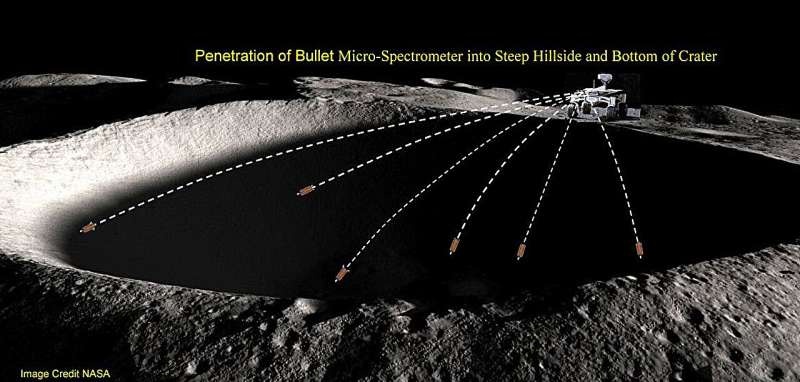NASA scientists have devised an ingenious method to analyze the composition of lunar craters by using miniaturized spectrometers that can be ‘shot’ into the ground. This groundbreaking technology is revolutionizing our understanding of the moon’s geological makeup and could have far-reaching implications for space exploration.

Lunar Composition: Micro-Spectrometers
These spectrometers were traditionally large and unwieldy devices, which is absolutely no good for in-situ work on something like an alien planet. But NASA scientists, Sang Choi and Robert Moses, have come up with the game-changing solution: a series of hand-portable miniaturized spectrometers.
These micro-spectrometers use Fresnel’s diffraction, which enables them to be much smaller than conventional spectrometers based on Fraunhofer diffraction. This advance allows all the required power, signaling and analysis electronics to fit within a tube barely larger than that of a conventional bullet.
Fired into the ground, these micro-spectrometers can map lunar craters in an inexpensive, high-throughput manner. The key here is that by deploying many sensors throughout a crater it would allow one astronaut or rover to explore vast area of the sample needed to come up with a complete understanding of the soil, without crew time consuming manual exploration.
Unprecedented Way of Exploring the Space
The approach shooting sensors into the ground is not only innovative, but provides a practicable solution to the challenges due to space exploration. Collecting soil samples from cosmic bodies just via astronauts hand-digging or precise extricating is a conventional and tedious job.
The micro-spectrometer technology means that a rover or an astronaut at some distant point in the not-so-distant future can just ‘fire’ the sensors into the ground to collect information over a much wider area. Such method might prove to be particularly valuable in some permanently shadowed regions within lunar craters, where wheeled rovers would not be able to operate due to sunlight deprivation.
The capabilities of this technology go beyond the moon, it can also be used to explore asteroids or even Mars. With those micro-spectrometers attached to platforms orbiting our neighbouring celestial bodies, we could then quickly sample the rocks of those worlds as the payloads returned, offering guidance for future missions and resource extraction.
Conclusion
This micro-spectrometer tech has helped in determining what other planets are made of and is a miracle for space exploration according to NASA. Firing these miniature sensors into extraterrestrial soils will allow scientists to very soon and at low costs map the composition of soil in lunar craters, asteroids and even Mars, opening up new avenues for learning about the geological history of our solar system. This paradigm shift not only eases the drilling operation but also has the ability to transform resource assessment and mining enabling a brand new period of space exploration, in this case, sustainable.
